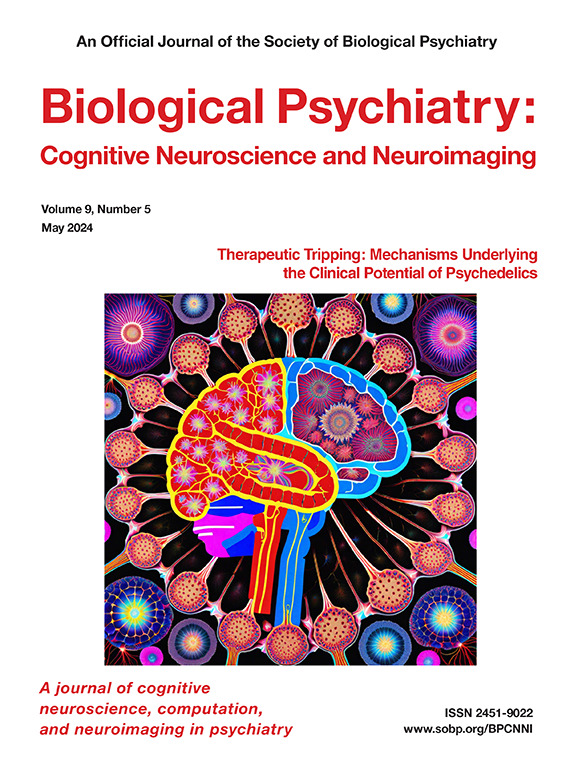Cortical Hypoactivation of Frontal Areas Modulates Resting Electroencephalography Microstates in Children With Attention-Deficit/Hyperactivity Disorder
IF 4.8
2区 医学
Q1 NEUROSCIENCES
Biological Psychiatry-Cognitive Neuroscience and Neuroimaging
Pub Date : 2025-06-01
DOI:10.1016/j.bpsc.2024.11.012
引用次数: 0
Abstract
Background
In the current study, we examined electroencephalography (EEG) microstate alterations and their neural generators during resting state in children with attention-deficit/hyperactivity disorder (ADHD) to explore a potential state biomarker.
Methods
A total of 76 participants, 38 with combined-type ADHD and 38 neurotypical children, took part in the study. Five-minute resting (eyes-open) 128 channel EEG data were acquired, and 2 minutes of clean EEG data were analyzed for microstates, its sources, and connectivity in both groups. Between-groups comparisons were done for microstate parameters using modified k-means clustering with Cartool software. Furthermore, the cortical sources and functional connectivity of significant microstate maps were explored using LORETA software. Subsequently microstate parameters were correlated with the behavioral scores from the Conners’ Parent Rating Scale.
Results
Among the microstate parameters examined, children with ADHD displayed significant differences (p < .05) in time frames and time coverage of map B (decreased) and transition probability of map D (increased). Interestingly, source analysis of both microstate maps showed hypoactivation of frontal areas predominantly while functional connectivity showed hyperconnectivity between the medial frontal gyrus and anterior cingulate gyrus (executive function area) for map B and hypoconnectivity between the medial frontal gyrus and middle temporal gyrus (both are suggested to be part of default mode network areas) for map D. Further, cross-spectral density values of map B were found to be correlated with executive function scores from the Conners’ questionnaire.
Conclusions
EEG microstate features, together with source and connectivity measures, could help differentiate children with ADHD from neurotypical children. The hypoactivation of predominantly frontal areas and their connectivity was found to determine microstate maps.
额叶皮质低激活调节多动症儿童静息脑电图微状态。
背景:本研究检测了多动症儿童静息状态下的脑电图微状态改变及其神经发生器,以探索一种潜在的状态生物标志物。方法:合并型ADHD和神经型儿童(NC)共76例,各38例。对两组5分钟静息(睁眼)128通道脑电数据和2分钟干净脑电数据进行微观状态、来源和连通性分析。在Cartool软件中使用改进的k均值聚类对组间微观状态参数进行比较。此外,利用LORETA软件对显著微状态图的皮层来源和功能连通性进行了研究。随后,微观状态参数与Conner父母评定量表的行为得分相关。结果:在检查的微状态参数中,ADHD儿童表现出显著差异(p)结论:脑电图微状态特征以及源性和连通性测量可以区分ADHD儿童和神经正常对照组。主要额叶区域的失活及其连通性被发现决定了微观状态图。
本文章由计算机程序翻译,如有差异,请以英文原文为准。
求助全文
约1分钟内获得全文
求助全文
来源期刊

Biological Psychiatry-Cognitive Neuroscience and Neuroimaging
Neuroscience-Biological Psychiatry
CiteScore
10.40
自引率
1.70%
发文量
247
审稿时长
30 days
期刊介绍:
Biological Psychiatry: Cognitive Neuroscience and Neuroimaging is an official journal of the Society for Biological Psychiatry, whose purpose is to promote excellence in scientific research and education in fields that investigate the nature, causes, mechanisms, and treatments of disorders of thought, emotion, or behavior. In accord with this mission, this peer-reviewed, rapid-publication, international journal focuses on studies using the tools and constructs of cognitive neuroscience, including the full range of non-invasive neuroimaging and human extra- and intracranial physiological recording methodologies. It publishes both basic and clinical studies, including those that incorporate genetic data, pharmacological challenges, and computational modeling approaches. The journal publishes novel results of original research which represent an important new lead or significant impact on the field. Reviews and commentaries that focus on topics of current research and interest are also encouraged.
 求助内容:
求助内容: 应助结果提醒方式:
应助结果提醒方式:


